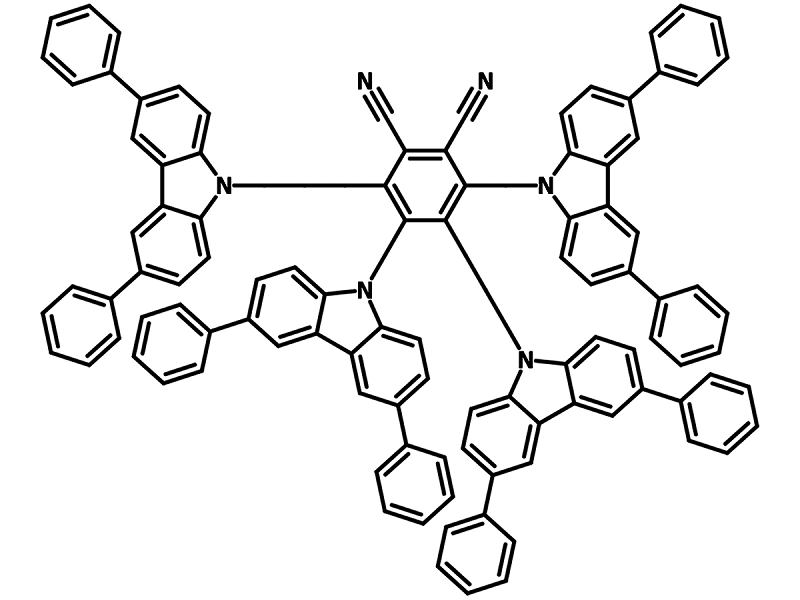4CzPN-Ph (4CzPNPh), a highly rigid carbazole based phthalonitrile derivative
Yellow emitter for highly efficient yellow and white TADF-OLED devices.
3,4,5,6-tetrakis(3,6-diphenylcarbazol-9-yl)- 1,2-dicyanobenzene (4CzPN-Ph), an iso-structure to 4CzTPN-Ph, has a fully substituted benzene ring with four bulky 3,6-diphenyl-9H-carbazoles and two ortho cyano groups at 1,2-positions.
Comparing with 4CzTPN-Ph, 4CzPN-Ph is structurally more hindered with all four diphenylcarbazolyl next to each other while four diphenylcarbazolyl are evenly separated in 4CzTPN-Ph. For this reason, 4CzTPN-Ph is relatively more conjugated is red-shifted in emission than 4CzPN-Ph.
4CzPN-Ph is a yellow emitter commonly used as a TADF dopant for highly efficient TADF devices. All TADF-based white organic light emitting diodes (WOLEDs) device with 4′-diphenylphosphinoylspiro[fluorene-9,9′-xanthene] (SFXSPO) as host, blue TADF material DMAC-DPS and yellow TADF material 4CzPN-Ph as the dopants, showed high device performance efficiencies with PE max of 40.6 lm/W, EQE max of 19.1%, and CE max of 50.5 cd/A.
General Information
| CAS Number | 1469707-47-8 |
|---|---|
| Chemical Formula | C104H64N6 |
| Molecular Weight | 1397.66 g/mol |
| Absorption | λmax |
| Fluorescence | λem |
| HOMO/LUMO | HOMO = 5.5 eV, LUMO = 3.3 eV (ET = 2.81 eV) [1] |
| Full name | 3,4,5,6-tetrakis(3,6-diphenylcarbazol-9-yl)- 1,2-dicyanobenzene |
| Synonyms | 4CzPNPh, 3,4,5,6-tetrakis(3,6-diphenyl-9H-carbazol-9-yl)phthalonitrile |
| Classification / Family | Carbazole derivatives, TADF yellow emitter materials, Phosphorescent organic light-emitting devices (PHOLEDs), TADF-OLEDs, organic electronics |
Product Details
| Purity | Unsublimed >98.0% |
|---|---|
| Melting Point | N/A |
| Colour | Orange powder |
Sublimation is a technique used to obtain ultra pure-grade chemicals. For more details about sublimation, please refer to the sublimed materials for OLED devices page.
Chemical Structure

Device Structure(s)
| Device Structure | ITO/MoO3 (6 nm)/NPB (70 nm)/mCP (5 nm)/SFXSPO:4CzPNPh (20 nm, 5%wt.)/SFXSPO (5 nm)/TPBi (30 nm)/LiF(1 nm)/Al [1] |
|---|---|
| Colour | Yellow |
| Max. EQE | 9.9% |
| Max. Current Efficiency | 27.9 cd/A |
| Max. Power Efficiency | 25.0 lm W−1 |
| Device Structure | ITO/MoO3 (6 nm)/NPB (70 nm)/mCP (5 nm)/SFXSPO:4CzPNPh (20 nm, 5%wt.)/SFXSPO:DMAC-DPS (20 nm, 10%wt.)/SFXSPO (5 nm)/Bphen (30 nm)/LiF(1 nm)/Al [1] |
|---|---|
| Colour | White |
| Max. EQE | 19.1% |
| Max. Current Efficiency | 50.5 cd/A |
| Max. Power Efficiency | 40.6 lm W−1 |
| Device Structure | ITO/MoO3 (8 nm)/TAPC (40 nm)/5CzOXD: 4CzPNPh (8 wt% 20 nm)/BmPyPB (40 nm)/LiF (1 nm)/Al [2] |
|---|---|
| Colour | Yellow |
| Max. EQE | 17.1% |
| Max. Current Efficiency | 50.6 cd/A |
| Max. Power Efficiency | 64.7 lm W−1 |
| Device Structure | ITO/MoO3 (8 nm)/TAPC (40 nm)/mCP:5CzOXD:4CzPNPh (66 : 33 : 1 wt%, 10 nm)/BmPyPB (40 nm)/LiF (1 nm)/Al [2] |
|---|---|
| Colour | White |
| Max. EQE | 9.9% |
| Max. Current Efficiency | 20.7 cd/A |
| Max. Power Efficiency | 33.4 lm W−1 |
| Device Structure | ITO/MoO3 (6 nm)/NPB (70 nm)/mCP (5 nm)/3-Sprio:4CzPNPh (5 wt%, 20 nm)/3-Sprio (5 nm)/TPBI (30 nm)/LiF (1 nm)/Al [3] |
|---|---|
| Colour | White |
| Max. EQE | 11.0% |
| Max. Current Efficiency | 32.5 cd/A |
| Max. Power Efficiency | 15.3 lm W−1 |
Pricing
| Grade | Order Code | Quantity | Price |
|---|---|---|---|
| Unsublimed > 98% | M2357B1 | 250 mg | £260 |
| Unsublimed > 98% | M2357B1 | 500 mg | £420 |
| Unsublimed > 98% | M2357B1 | 1 g | £660 |
MSDS Documentation
Literature and Reviews
-
A Significantly Twisted Spirocyclic Phosphine Oxide as a Universal Host for High-Efficiency Full-Color Thermally Activated Delayed Fluorescence Diodes, J. Li et al., Adv. Mater. 28, 3122–3130 (2016); DOI: 10.1002/adma.201506286.
-
Purely organic materials for extremely simple all-TADF white OLEDs: a new carbazole/oxadiazole hybrid material as a dual-role non-doped light blue emitter and highly efficient orange host, D. Zhang et al., J. Mater. Chem. C, 6, 3675-3682 (2018); DOI: 10.1039/c7tc04969b.
-
Super rigid tris-spirobifluorenes: Syntheses and properties, L. Zhao et al., Chinese Chem. Lett., 32, 397-400 (2021); DOI: 10.1016/j.cclet.2020.02.001.

 4CzPN-Ph MSDS sheet
4CzPN-Ph MSDS sheet